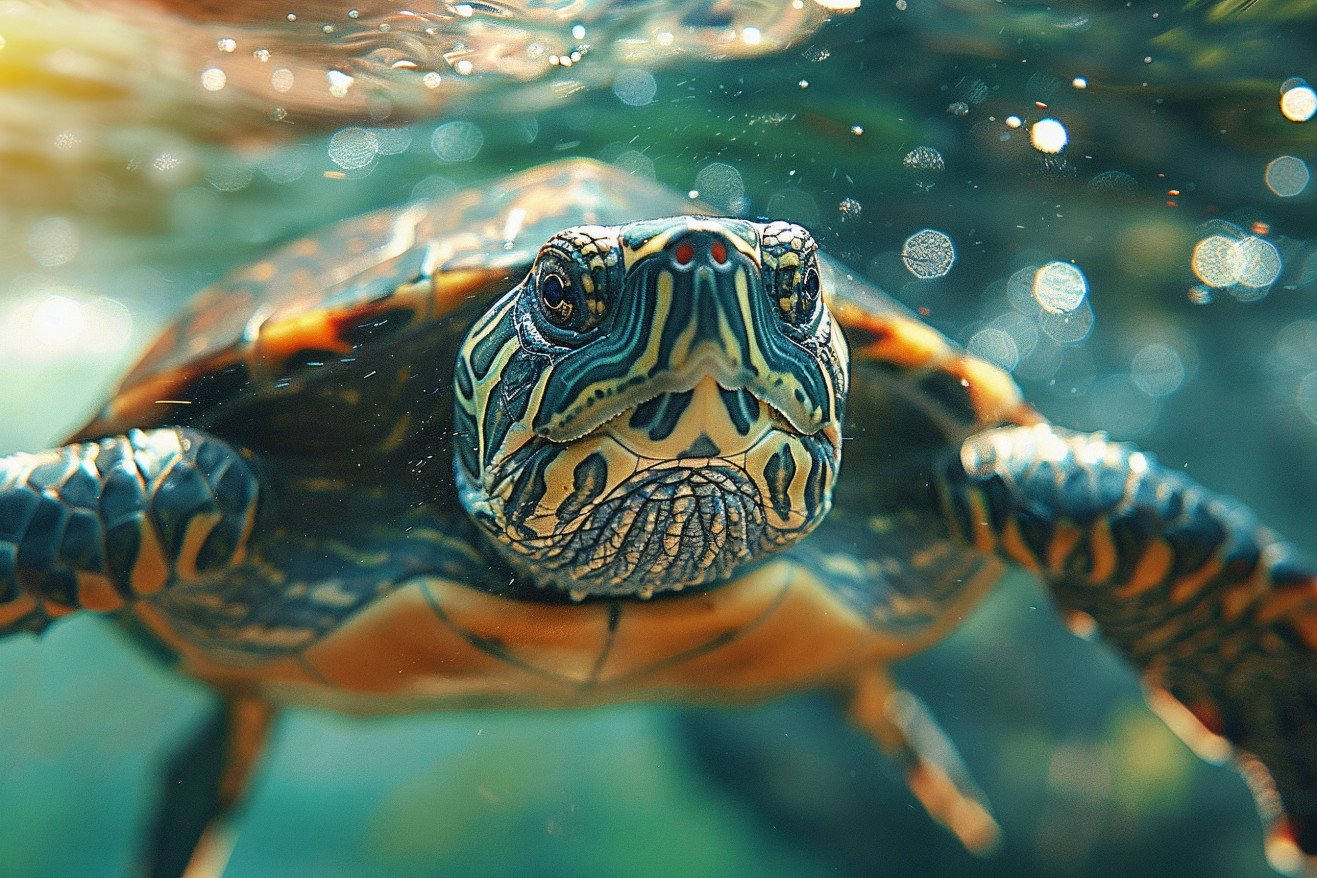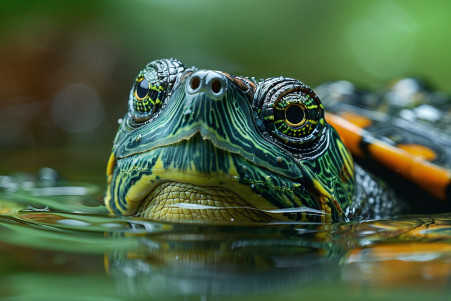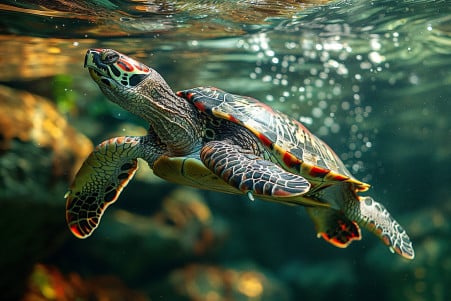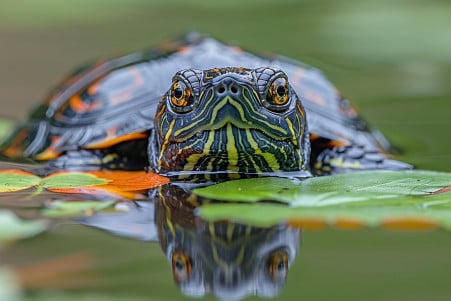Can Turtles Drown? Understanding Aquatic Risks for Turtles
20 February 2024 • Updated 19 February 2024

Turtles are well-adapted to life in the water, but can they drown? Yes, turtles can drown, but it happens when they are unable to come up for air. While turtles can stay underwater for long periods of time, drowning can occur if stress, entanglement in fishing nets, or other factors prevent them from surfacing to breathe.
This article will take a deep dive into animal science and marine biology to explore the situations in which turtles can drown. We will look at turtle biology, including their respiratory and diving physiology, to see how turtles typically handle the need to breathe air while living in the water.
We will also explore natural and human-induced factors that can prevent turtles from surfacing to breathe. By the end of this article, you will have a well-rounded view of the risks turtles face in the water.
Can turtles drown?
The Apnea Masters: How Turtles Survive Underwater
Green sea turtles have developed impressive apnea abilities, and this is due to their unique respiratory physiology. Notably, green sea turtle blood has a very high oxygen affinity, which helps the turtles take up oxygen more effectively during the intermittent breathing while swimming, according to a study in the Journal of Comparative Physiology B.
In addition, specialized muscles that help with lung ventilation have evolved to help them survive in the water, according to a study in Nature Communications. Unlike other amniotes, turtles lack intercostal muscles that help expand the ribs, and instead, they use two sets of hypaxial muscles to ventilate their lungs, a system that has evolved to accommodate their shell-encased bodies and aquatic lifestyle.
In addition, a study in PubMed found that loggerhead sea turtles have evolved their respiratory mechanics to reduce airway resistance and the muscular work of breathing, similar to marine mammals. These physiological changes help them with their endurance swimming and diving, allowing them to stay underwater for longer periods of time.
However, environmental conditions or human activities can disrupt these finely tuned physiological adaptations, making the turtles more prone to drowning. Therefore, it’s important to protect these adaptations, which are essential for the turtles’ survival in their underwater world.
The Dive Dynamics: Turtles and the Risk of Drowning
Turtles are known for their diverse diving and swimming habits, which can change based on their environment, age, and species.
For example, the South Carolina Department of Natural Resources’ MRD In-Water Sea Turtle Research team found that juvenile loggerheads have site fidelity, meaning they return to the same place over and over again, even after being captured and released.
This shows that turtles are creatures of habit and need a certain environment to survive. Meanwhile, the Olive Ridley Project found that turtles have different breath-holding abilities based on their levels of activity.
Yet, these behaviors can change when turtles are stressed or when they are participating in activities like feeding or mating, which can lead to a decrease in their breath-holding ability.
When turtles are caught in ghost nets, their oxygen levels can drop quickly, which can lead to drowning in a matter of minutes.
Although turtles are generally good at regulating their need for air, a study in Marine Biology found that turtles’ behavioral responses to unusual or stressful situations can be overridden, which can lead to an increased risk of drowning. These findings about turtle diving dynamics show how important it is to balance their natural behaviors with their survival in the changing waters of the world.
The Human Factor: Impacting Sea Turtle Survival
Human activities have turned the world’s oceans from safe homes for sea turtles to increasingly dangerous environments. For example, plastic pollution has had devastating impacts on sea turtles. According to WWF-Australia, sea turtles often eat plastic waste, mistaking it for food, and this can lead to them swallowing it and potentially clogging their digestive systems, which can lead to death by drowning.
The University of Exeter’s study found that turtles caught in fishing gear had a shocking 91% chance of dying, and this gear can prevent them from surfacing to breathe.
In addition, Published research from CSIRO found that a turtle’s likelihood of death increases by 22% with the consumption of just one piece of plastic, and this likelihood increases with the amount of plastic consumed, demonstrating the serious threat that pollution poses to sea turtle populations.
In addition, conservationists are working to fight against the loopholes that have allowed some shrimp trawlers to not use Turtle Excluder Devices (TEDs), a loophole that Defenders of Wildlife points out in their list of ways to prevent unnecessary sea turtle deaths by drowning in fishing nets.
It’s clear that reducing bycatch and the risk of drowning due to fishing is essential. TEDs have been shown to reduce sea turtle deaths when they are used properly, and this is highlighted by the ongoing lawsuits that are challenging policies that have weakened their use. Protecting sea turtles from these human-caused dangers is essential not only for the survival of the species but also for the health of the world’s oceans.
Breaking Down Turtle Tenacity: How Turtles Can Hold Their Breath for So Long
Turtles are nature’s ultimate free divers, and they use a variety of physiological adaptations to avoid drowning during their long dives. In the case of the leatherback turtle, Nathan J. Robinson’s research has shown that leatherbacks can control the amount of air they take in before a dive, which suggests that they have a high level of control over buoyancy and oxygen storage.
In fact, leatherbacks and other sea turtles have the highest oxygen storage capacity of any sea turtle, and it’s spread out among their blood, muscles, and organs.
In addition, turtles have an impressive tolerance to anoxia, or a lack of oxygen. Research published in PubMed Central has shown that freshwater turtles can survive for weeks without oxygen by dropping their metabolic rates and using powerful antioxidant defenses. This tolerance to anoxia is a result of both physiological adaptations and biochemical adaptations, and it allows turtles to survive for long periods with little to no oxygen.
In addition, the leatherback’s ability to dive to depths of 1,280 meters and stay underwater for as long as 86 minutes, as shown in Sabrina Fossette’s research on buoyancy regulation, is especially impressive. The turtle’s diving reflex, among other adaptations, makes these feats possible by conserving oxygen and reducing the risk of decompression sickness by ensuring a slow ascent.
These physiological adaptations don’t just help turtles dive, they also help them live long, healthy lives, as their strong stress resistance mechanisms are an indirect result of their negligible senescence. While we can continue to marvel at the resilience of these oceanic survivors, it’s clear that their amazing diving abilities are not without limits, and going beyond those limits can lead to drowning.
Lifelines in the Water: The Impact of Turtle Drowning Events
After a drowning event, sea turtles rely on humans for their survival and recovery. The rescue process starts with saving the turtles that have been impacted by drowning events. For the Olive Ridley Project, this means providing veterinary care and rehabilitation to turtles that have been disabled by entanglement or pollution so that they can be released back into the wild.
Rehabilitation centers, like the ones in Queensland, Australia, have taken in stranded turtles, many of which only have buoyancy disorders, and have been able to rehabilitate and release them back into the wild, according to PMC.
The study found that 39% of the turtles that were rehabilitated were released back into the wild by the rescuers. However, the success of these efforts can depend on the cause of stranding and the condition of the turtles when they are found.
A different study by PMC found that the use of environmental enrichment during rehabilitation can improve the welfare and increase the chances of survival for sea turtles after they are released. These examples of successful rehabilitation show how rescues fit into the larger conservation picture by giving marine animals a second chance and helping to mitigate the impact of drowning events.
Given the long-term impact of these rescues, it’s clear that rehabilitation efforts help ensure the survival of individual turtles and are a major part of the effort to conserve marine ecosystems. These examples of successful rescues show the positive impact of human intervention and the role that we play in the ongoing fight against the waterborne threats that sea turtles face.
A Meditation on the Hazards of the Water World: A Recap
In the watery depths of the world’s oceans, lakes, and rivers, turtles must constantly negotiate the fine line between life and the ever-present threat of drowning. Despite their extraordinary diving abilities and physiological adaptations for apnea, turtles are not immune to the perils of their underwater environments. From respiratory impairments to hyperactivity to unlucky encounters, a variety of factors can turn their aquatic worlds into death traps.
Human-induced pollution and fishing practices only make matters worse, and the consequences are often fatal. Yet, there is also reason for hope as conservationists continue to make strides with Turtle Excluder Devices, and wildlife rehabilitation centers continue to do their important work. The success of these efforts is a reminder of the critical role we play in protecting these ancient creatures.
As we meditate on the hazards of the water world, let us also remember the fate of turtles and humans are inextricably linked. Our knowledge of turtle physiology, behavior, and the impacts of human-induced hazards is essential for making informed decisions about conservation.
By advocating for the study of marine biology and the protection of wildlife, we can ensure that turtles will continue to perform their silent ballet beneath the waves for generations to come.


